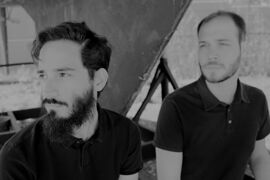
Air on the Edges

by Anjulie Rao (MA 2014)
The Fern Room of the Lincoln Park Conservatory is teeming with life. Plants ornament the walls, hang from the ceilings, and reach out to passers-by. The hot, sticky air is matched by the cool, green fronds of the ferns. It smells of wet wool. Amid this bombardment of the senses, visitors hear something peculiar: initially, sounds of air accompanied by muted tones and vocals. It escalates, growing in intensity and rich in timbre. It is musical, but sags with the heavy breaths of tubes and pipes until the room becomes a living, respiring entity.
Droopy is a sound installation at the Lincoln Park Conservatory made by Coppice, a duo composed of SAIC alumni Noé Cuéllar (BFA 2009) and Joseph Kramer (MFA 2010). Commissioned by Experimental Sound Studio for its Florasonic series at the Fern Room, Droopy is one of many projects Coppice creates using custom-made sonic devices, as well as voice, pump organs, electronics, and accordions. Though their projects range from compositions and recordings to sculpture and performed installations, Coppice consistently produces transcendent, undulating music that excites the senses and haunts the imagination.
Coppice formed shortly after Cuéllar and Kramer met in a class at SAIC. After seeing each other perform, they immediately took to one another’s work and began collaborating. "We were very interested in making live performances that had a high regard for the audience and were very directed toward them,” says Cuéllar. "It made sense to try and do something together.”
Their choice of instrumentation began very simply: a modified boom box capable of simultaneous recording and playback and a small, bellowed organ. "The tape processes and bellows-driven instruments are where much of our live repertoire comes from. We are very interested in pairings that have Noé on one side and me on the other—both dealing with the same material from different aspects,” states Kramer.
Since their time at SAIC, Cuéllar and Kramer have developed their practice to include sound objects, a varied discography, installations, and live performances. Regardless of the context, their process involves "probing the spaces between objects and their sounds.” "We record objects with very close mic-ing techniques as a way of getting at the different angles that objects make sound,” Cuéllar elaborates. In this manner, Coppice is able to produce both complex music and objects.
"The inverse of [the composition process] is what happens when we make objects: we take certain aspects of sound and re-embody them in sculptural works, to see how changing the body that they inhabit changes the experience of that sound,” says Kramer.
One "rotational" exploration into sound-objects is their ongoing work, Vinculum, an archive of "sonic artifacts.” Their instruments and objects—made from materials such as copper, wood, steel, and clay—are recorded in ways that highlight their sonic aspects, often in interaction with air pressure. The resulting recordings are integrated and recontextualized in other modes of listening, such as compositions and installations.
Fluidity is key to Coppice. It emerges prominently in their practice and is particularly important when considering their work as object makers, musicians, and audiovores: "We try to approach our ideas without much prejudice. Sometimes our ideas are sculptural. Our projects might begin as installations and then later develop themselves into a music composition or a recording project,” says Cuéllar.
Still, the most captivating element of Coppice’s work is the role of breath—evident in the Fern Room experience. It is present in both obvious ways (the "breathing” of bellow instruments) and in the subtleties of rhythm and intensity. Kramer explains, "Air is rarely a sonic material on its own. It’s really about the air and the edges, the things that get in the way of the air. Performing gestures with those edges is a big part of how air works. We also think about the time scale of air and how it relates to the human body—making compositions that relate to the time scales of the breaths that we take.”
Coppice’s fluid processes and dynamic experimentations with sound, air, and objects result in sounds that are alive—they breathe, pause, pass through objects, and maneuver easily between spaces. From their icy, austere work to their humid, "florasonic” ambiances in the conservatory, Coppice is breathing new life into Chicago’s experimental music scene.
Check out Coppice’s sound installation, Droopy, in the Lincoln Park Conservatory’s Fern Room through November 10.
Coppice also performs at the 10th Anniversary of Noisefest at Lemp Neighborhood Arts Center in St. Louis, Missouri, on November 2.
Listen to a composition [MP3]
